
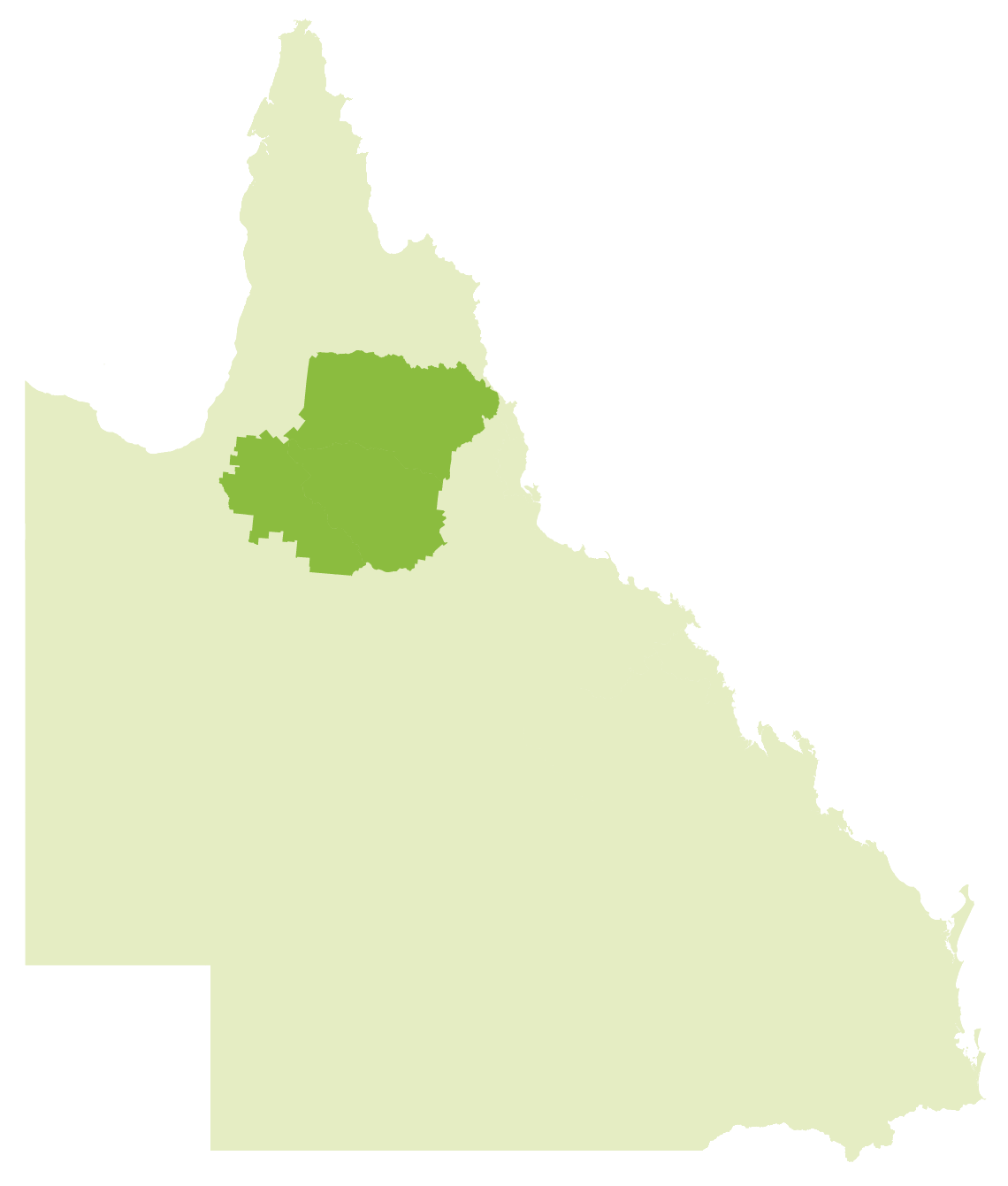
Overview of Gulf Hinterland
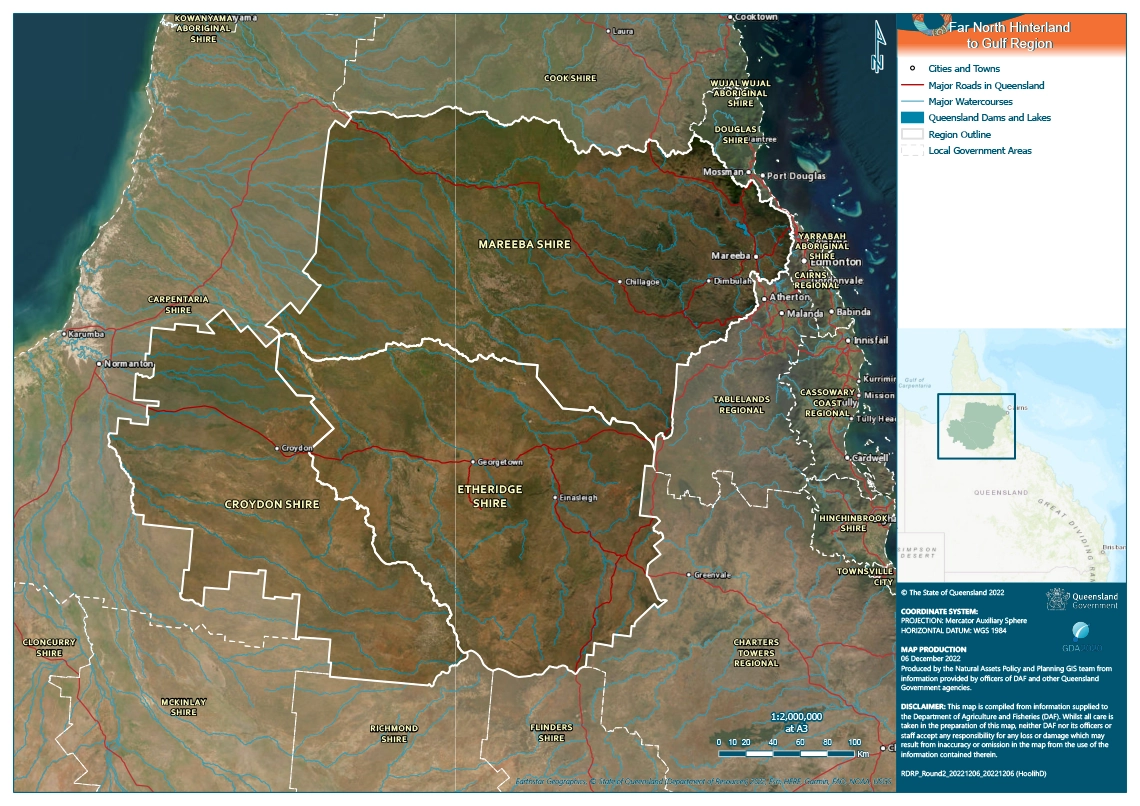
The Gulf Hinterland region is a unique and tropical landscape of exceptional diversity.
It comprises three Local Government Areas (LGAs) managed by the Mareeba Shire Council, Etheridge Shire Council and Croydon Shire Council. The region has a total land area covering approximately 123,000km², approximately 7% of the Queensland land area. The natural landscape extends from the high-rainfall areas of the World Heritage listed Wet Tropics in the east, to the vast, weathered, low plain – dominated by meandering rivers and large floodplains in the west. East of the Great Dividing Range provides for pristine rainforest of the Kuranda Range and extends west across the vast Savannah with more arid landscapes. The area contains a wealth of Indigenous heritage, high conservation values and natural resources.
Drought in this region takes different forms. Every year, however, there is a long dry season of variable intensity. Sometimes, the wet season comes late or finishes early, and consequently, the dry season can be very long. On rare occasions, the wet may fail altogether. The understanding of drought in the Gulf Hinterland is linked with weather conditions that are strongly correlated to higher temperatures and heatwave conditions, reductions in rainfall, increased evaporation, and increased variability in rainfall patterns.
Past impacts of drought in this region
Past impacts | People, culture & community
EXTRACTS FROM THE FULL RDRP PLAN
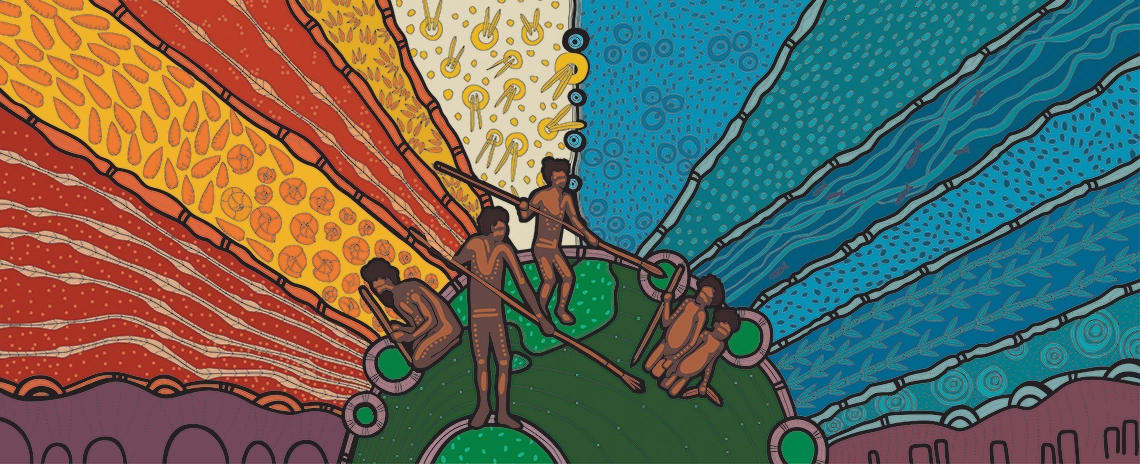
The effects of drought on Gulf Hinterland communities have included:
- heat-stress due to prolonged hot weather
- inequitable outcomes for people who do not have access to air-conditioned houses or heat safe places such as shopping centres
- acute and chronic physical impacts, e.g. from dust and air quality
- increased mental health impacts, including suicide
- impacts on vulnerable individuals and communities, e.g. elderly, First Nations and/or remote individuals, people with disabilities, those in the low socioeconomic demographic, and the homeless
- increased burden on social and primary healthcare networks
- impacts on liveability, e.g. damage to recreation areas and parks, housing
- outmigration and population loss
- loss of food security
- hardship, trauma and stress
- higher levels of isolation and social disconnection
- reduced vibrancy of rural businesses and towns
- increased cost of living expenses, e.g. due to purchases of potable water
- depletion of social capital.
Past impacts | Economy
EXTRACTS FROM THE FULL RDRP PLAN
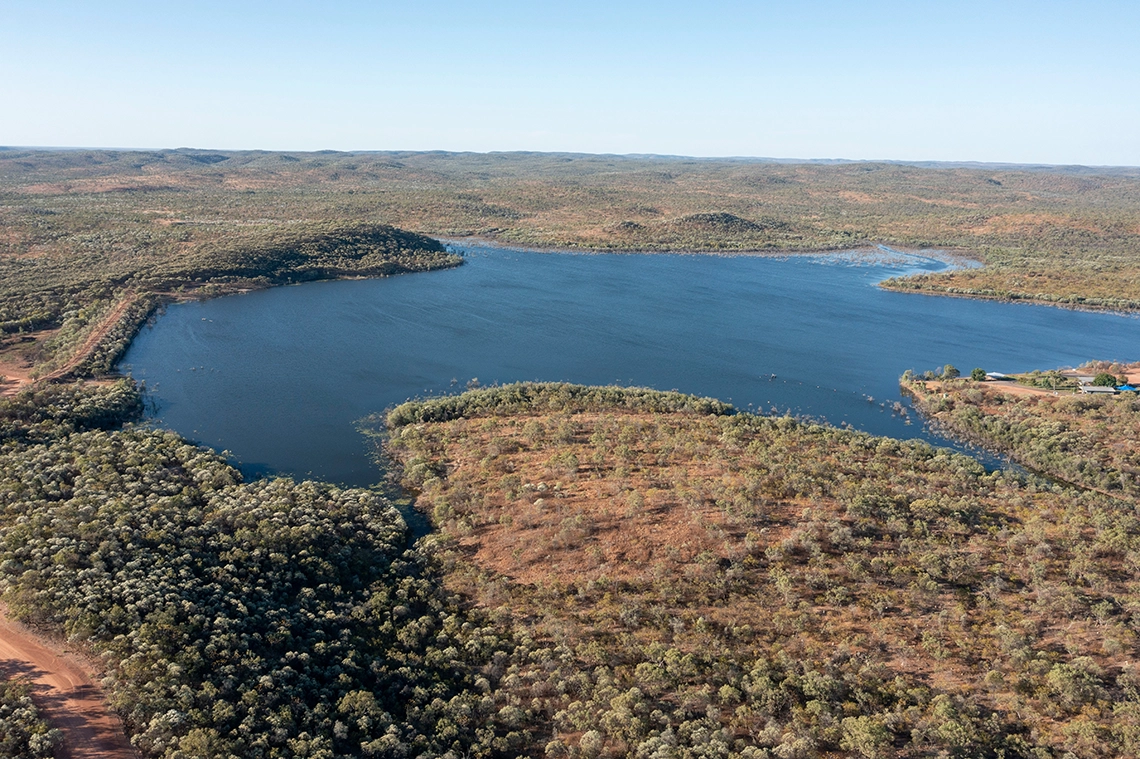
The effects of drought on the Gulf Hinterland economy have included:
- higher cost of running businesses, e.g. additional water costs and increased power costs for irrigators
- soil degradation, poor pastures, heat stress on animals, weight gain and ultimately de-stocking
- irrigated water reliability, rising costs of inputs of water, power, quality of produce, market value
- reduced productivity
- vulnerability of workforce to heat stress
- loss of viability of businesses with flow on impacts across the supply chain, including impacts on employment, income, transport
- changed harvesting times, response particular species of fruits and vegetables to heat, pollination failures, increased pests and weeds reducing quality of crops
- impacts of heatwaves on tourists and reduced tourism
- repair costs for infrastructure and ecosystems
- heat stress on animals, pasture conditions
- loss of inter-generational skills and knowledge of farming and land management due to outmigration
- regional ripple effects in Gulf Hinterland and surrounding regions affecting industries, income, and employment.
Past impacts | Landscape and natural environment
EXTRACTS FROM THE FULL RDRP PLAN
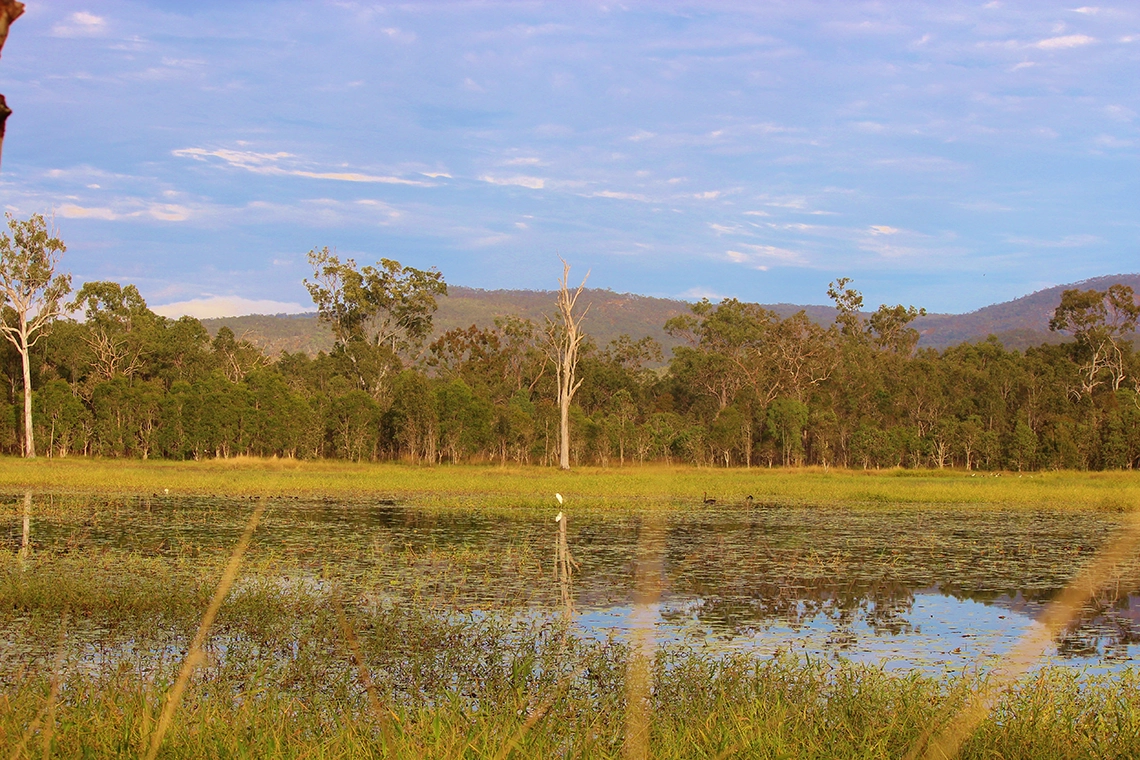
The effects of drought on the Gulf Hinterland landscape and natural environment have included:
- biodiversity impacts (distribution and number), particularly on endemic species, e.g. birds, and fish
- heat stress on natural assets such as streams, creeks and waterfalls
- soil erosion and depletion of soil quality, including loss of moisture and salinity
- sediment in rivers and waterways
- increased catastrophic fire risks
- drying of rivers and creeks
- depletion of above and below ground water sources, and flow on impacts
- increased invasive pests and weeds, including feral animals and locusts
- degradation of land and water assets including increased pollutant levels and lower levels of oxygen in the water
- impacts on the acidity of oceans and endangering tidal mangroves resulting in fish reproduction impacts
- weeds and pests replacing native flora
- increased dust
- greater pressures on the environment, post drought.
Past impacts | Infrastructure and built environment
EXTRACTS FROM THE FULL RDRP PLAN
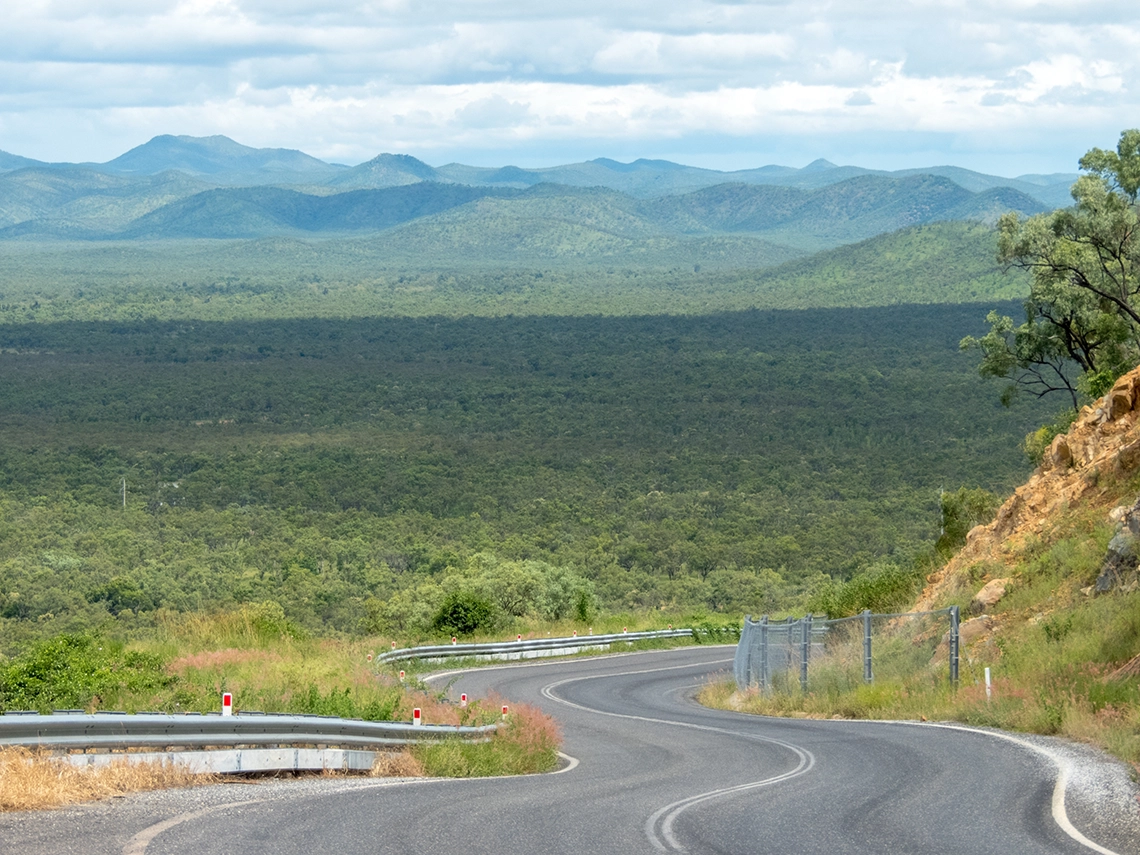
The effects of drought on the Gulf Hinterland infrastructure and built environment have included:
- impacts on roads, bridges and transportation networks, e.g. major beef roads cracking, dust and dangerous conditions
- heat and fire impacts on infrastructure, e.g. buckling of roads
- impacts on recreational areas, e.g. sports fields, parks and water parks
- damage to digital connectivity and disruption of service, e.g. fire, heat
- increased maintenance and repair costs of existing infrastructure
- impact on potable water supplies
- overuse of air-conditioning with subsequent challenged power supply
- increased precipitation in water sources and dams.
Likely future impacts of drought in this region
Future impacts | People, culture & community
EXTRACTS FROM THE FULL RDRP PLAN

Projected changes to climate indicate periods of extreme heat will become more common and hotter. Increasing maximum temperatures associated with drought conditions will mean more people will be vulnerable to heat-related illnesses and stress – especially sick, elderly and very young people; and people living without air-conditioning. The increasing pattern of temperatures will have impacts on sleep quality, especially for households without air conditioning.
There will also be an increase in the use of air conditioning, placing pressure on energy supplies.
Water carries significant cultural values for First Nations people, therefore changes to rainfall patterns affecting the health and availability of fresh water will impact these cultural values. Some participants in the engagement also raised concerns about the connection between the health of Country and the physical and mental wellbeing of First Nations communities.
Future impacts | Economy
EXTRACTS FROM THE FULL RDRP PLAN
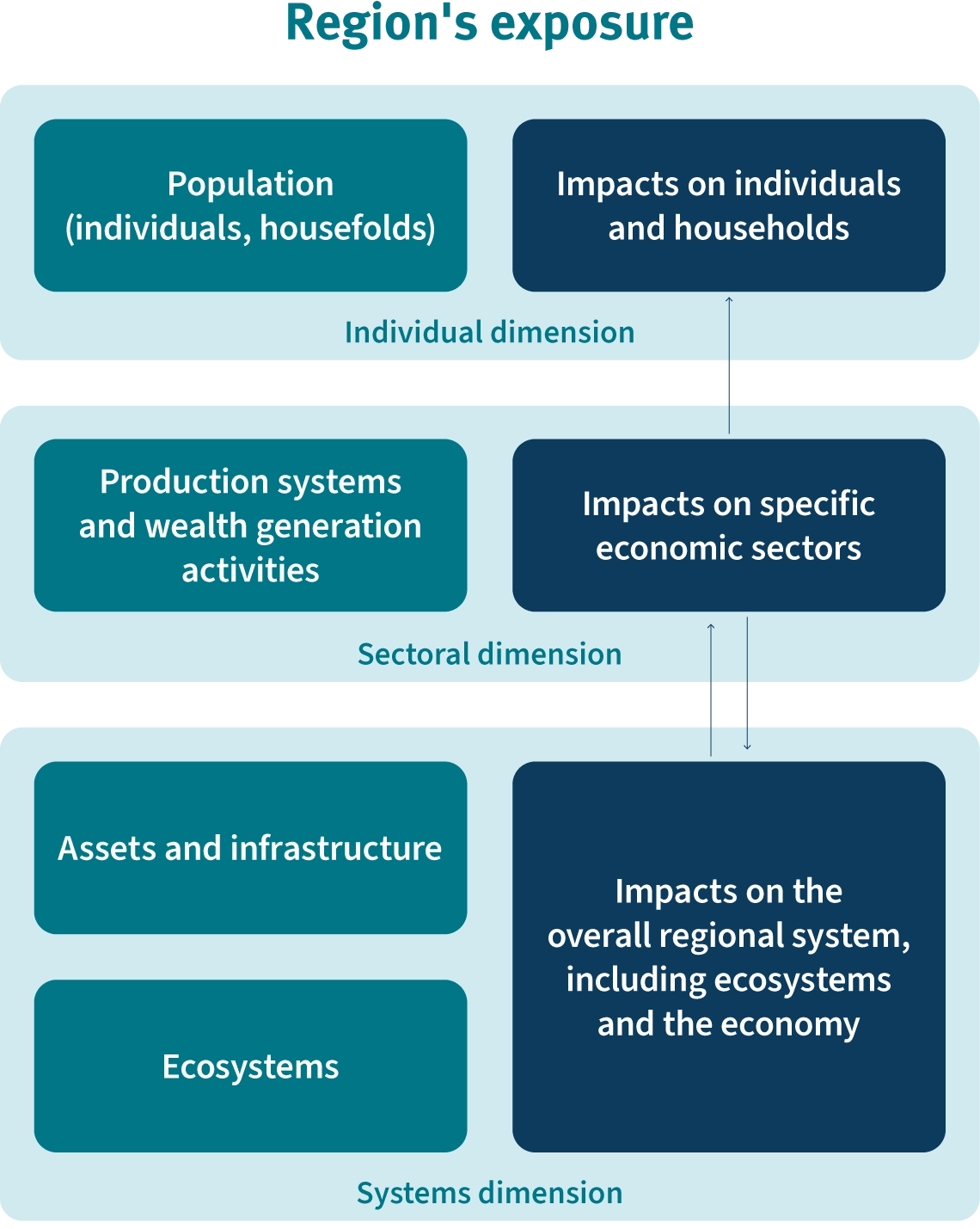
Specific risks to primary industries include:
- direct loss of crops and livestock
- reduced production and profitability of farms
- increased competition or cost for available water
- changes to pollination, growth, flowering or fruiting patterns.
In some cases, it may be necessary to assess the long-term viability of some crops or livestock breeds and either switch management practices, cultivars or breeds.
Drought and more extreme weather events in the region have also had a significant impact on business confidence. Water security issues could influence the number and types of businesses willing to operate in the region. Conflict over water use has been identified as a potential future issue. Finally, the drought impacted towns have lost populations. Future drought will impact on the future of towns, services and flow on impacts such as workforce skills and shortages.
Future impacts | Landscape and natural environment
EXTRACTS FROM THE FULL RDRP PLAN
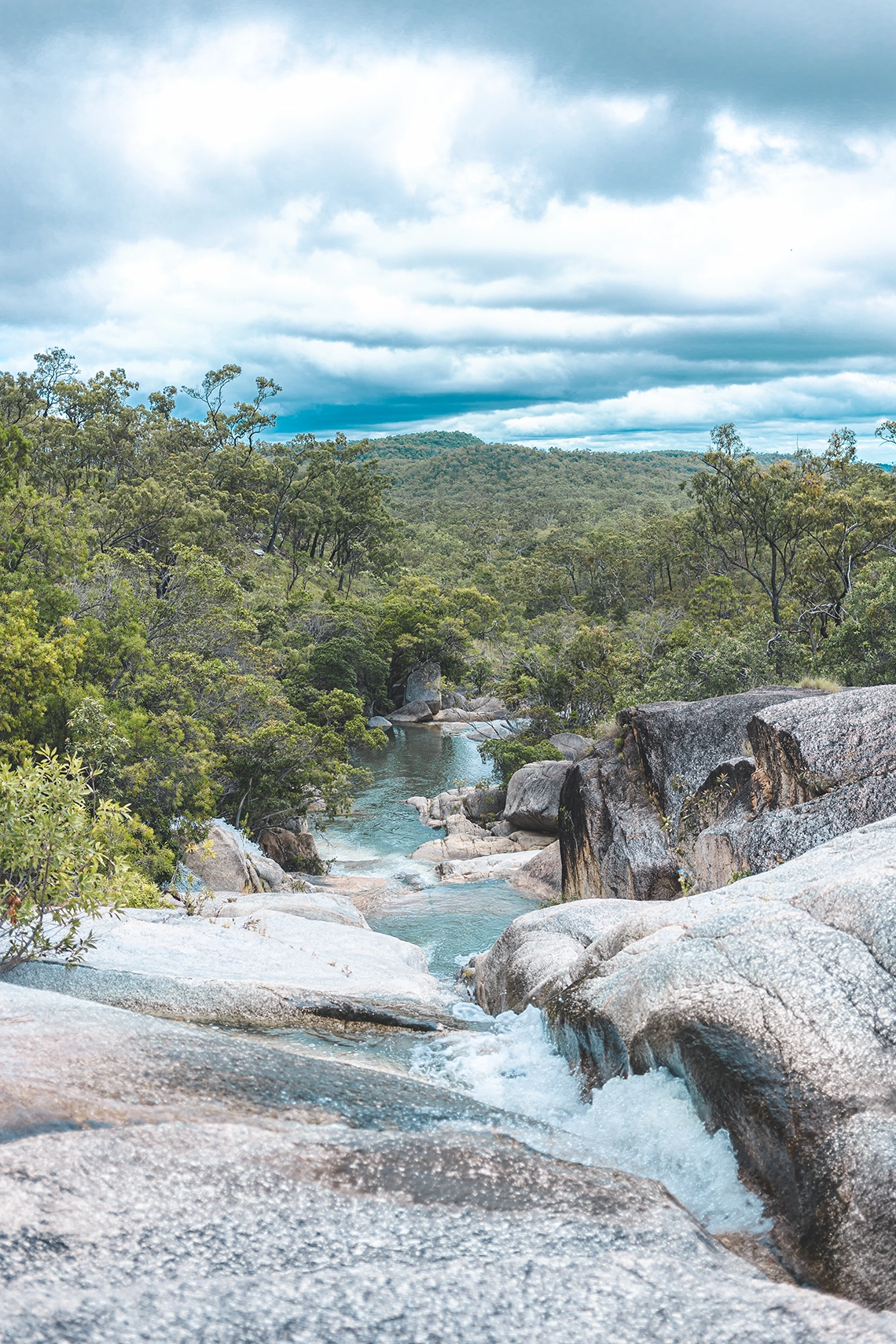
Any future drought will have an immediate and direct effect on the landscape and natural environment. In the event of a future drought, it is expected to observe increased bushfire risk, reduced ground cover, biodiversity impacts, increased aquifer salinity, degradation of existing waterways, increased weeds and pests, poor pasture quality, and degradation of cultural sites.
Future impacts | Infrastructure and built environment
EXTRACTS FROM THE FULL RDRP PLAN
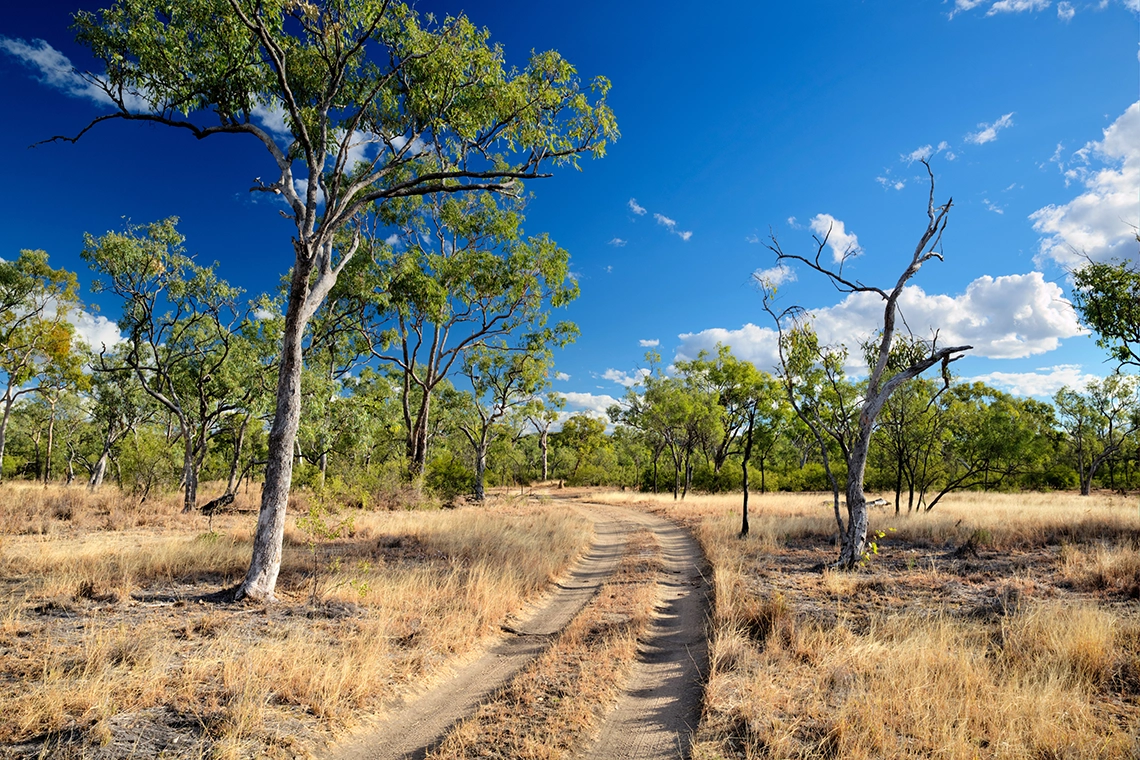
Many regional areas, including the Gulf Hinterland, have aging public and private infrastructure that has not necessarily been designed to meet future climate conditions. In addition, areas that are not currently considered to be at risk of severe bushfires may become more vulnerable as fire weather increases and vegetation changes.
Hot, dry weather can impact Council road maintenance and construction, and may mean staff who work outside – such as in roadworks, construction and agriculture – may need to switch to night work during hotter months.
Higher temperatures associated with drought will increase demand for air conditioning and energy use in homes and businesses. This will place pressure on power generation and transmission during times of peak demand and could result in widespread power failures, with associated disruptions to people and businesses and the possibility of heat-related health impacts.
Severe drought can also lead to soil cracking, increasing the risk of subsidence and building damage.
Regional strategy
Security in water, energy and connectivity.
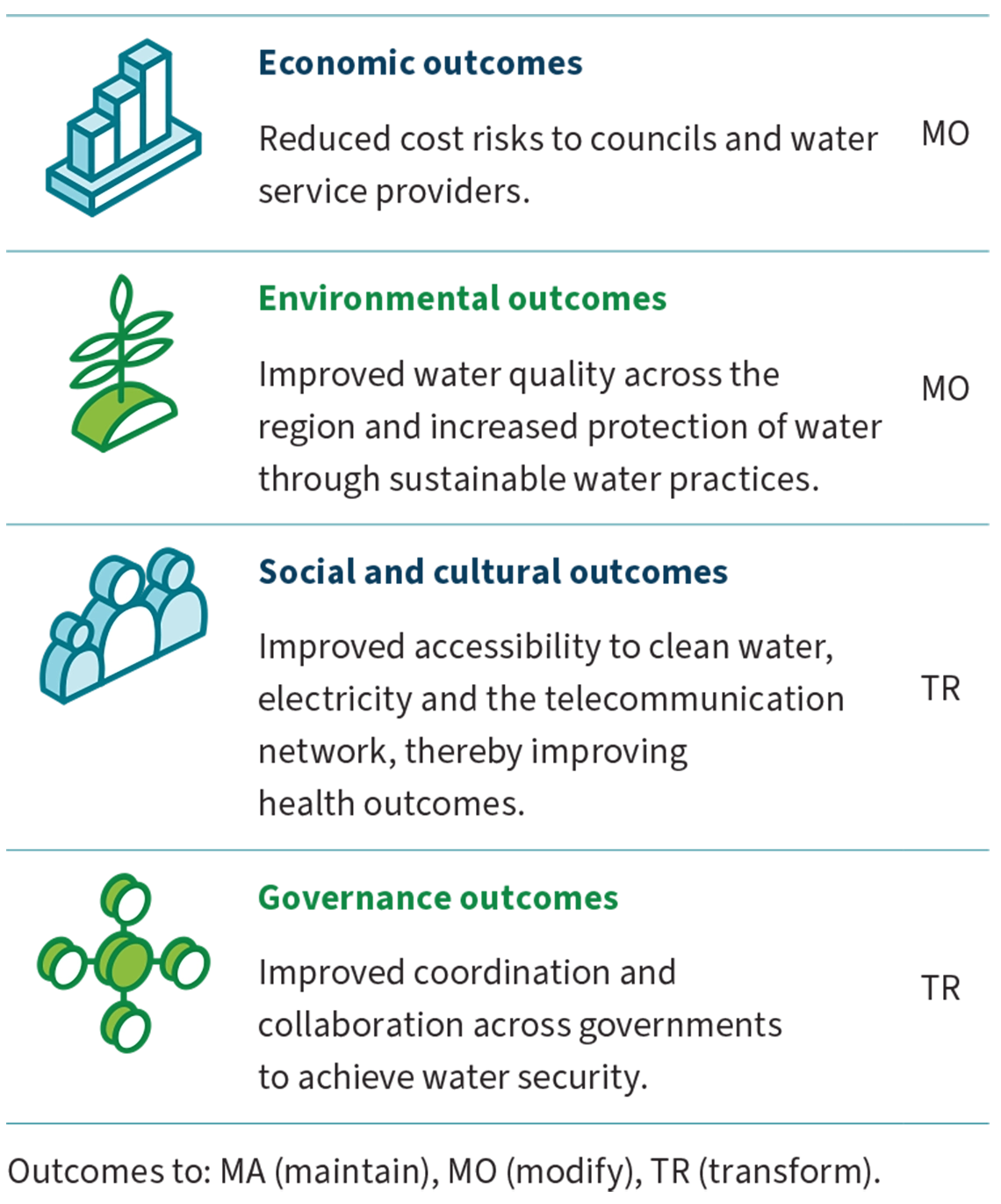
While deeply affected by drought, the Gulf Hinterland region has significant water available for future (but sustainable) consumptive use, some 2,000GL. While the region suffers significantly from drought at present, effective action on this front could position the region as one of the nation’s most hyper-secure regions from a water perspective.
Support measures towards economic resilience in the business and agriculture sectors by diversifying and adapting to drought conditions.

Economic revitalisation and diversification across key towns in this region is key to long term drought resilience. This means building strong business and sector capability across the economy and building on economic, human, and natural assets. The economy of the region is heavily influenced by the agricultural and tourism industries with many employees working outdoors. Addressing business level vulnerability, ensuring appropriate workforce and skills development, adopting new technologies and identifying and mitigating climate risks are critical measures for the region.
Build community resilience through ongoing support of mental and physical health, wellbeing, capacity building and community connections.

A strong sense of community and individual support mitigates some of the psychosocial impacts of drought and other natural disasters. It is important support services are available before the severe impacts of drought are felt within communities. Supporting the capacity of community organisations and service providers, as well as the accessibility of services, is fundamental for future drought resilience.
Manage landscapes more effectively, protect property and prepare natural and cultural assets for drought impacts to conserve ecosystems and vulnerable species.
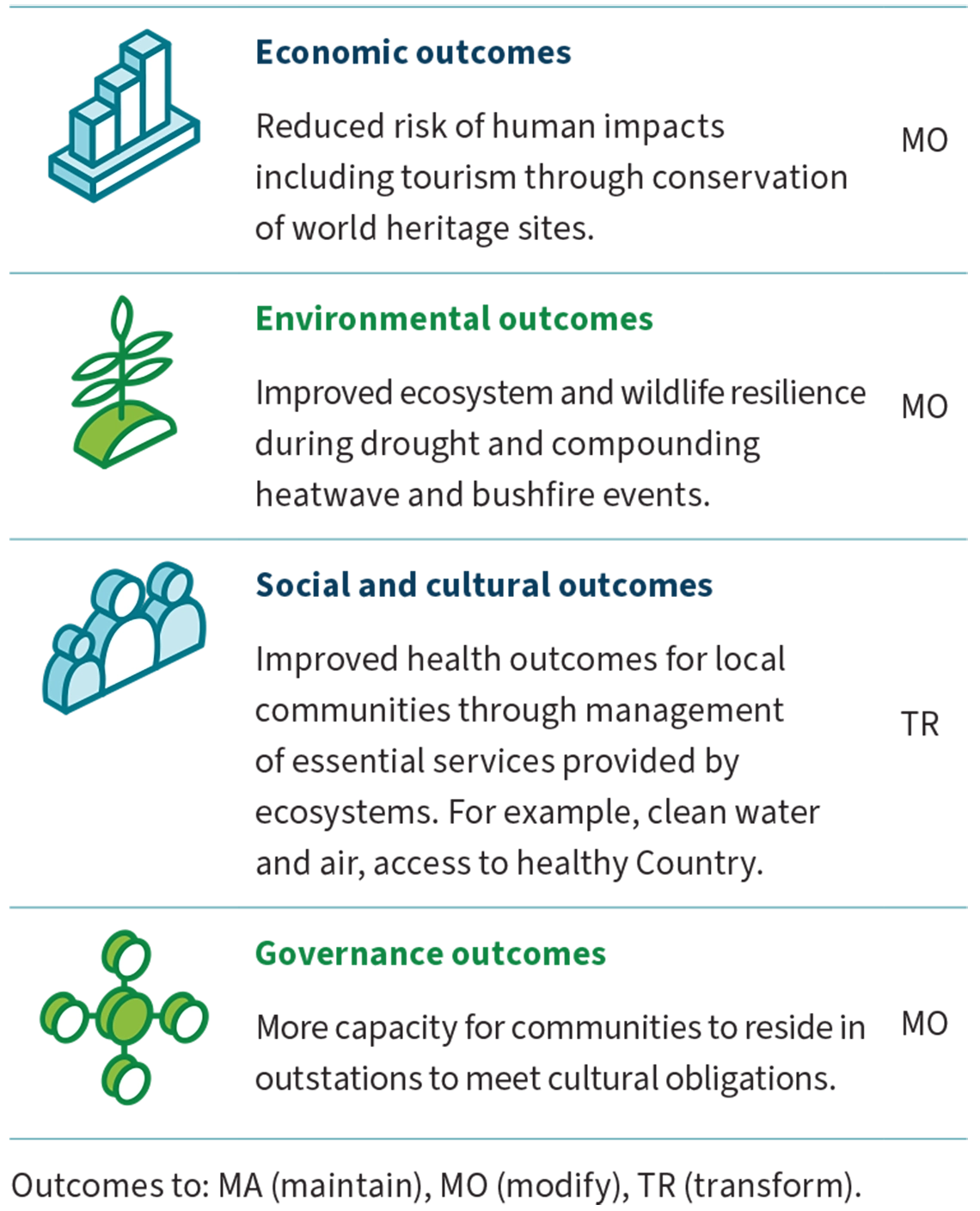
The Gulf Hinterland region has a unique productive and cultural landscape and ecosystem facing threats and challenges. Bushfire risk becomes particularly significant in drought periods – threatening lives, property, environment and cultural values. Equally, these values are best protected through cohesive landscape scale management, including proactive fire management and cultural burning approaches. Through proactive landscape management and stronger emergency response, the protection of the ecosystems is vital for human health, clean water, air, and healthy soils – driving tourism and supporting regional economies.
Support First Nations people to be drought resilient and ensure they have equal access to healthy Country.

First Nations peoples have interests and rights across the Gulf Hinterland landscape. They also hold invaluable lived experiences with drought events – offering crucial insights into building resilience against impacts like water scarcity, bushfires, and heat-stressed conditions. Fostering collaboration is essential for cultivating resilience and maintaining the wellbeing of both communities and the country. There is significant economic disparity which exacerbates the challenges faced during drought. Achieving equitable access for all First Nations people to maintain healthy Country and people is imperative, particularly in the face of climate-driven events such as drought.
Support regional governance capacity to deliver regional drought resilience.

Achieving drought resilience in the Gulf Hinterland region demands long term partnerships and coordinated efforts across diverse sectors and organisations, including three levels of government and civil society. Essential governance actions include aligning with established climate-resilient strategies and plans, and strategically placing drought resilience within broader regional climate resilience goals. In fostering collaboration and strategic governance, the region can effectively address the multifaceted challenges posed by drought, ensuring sustained environmental, social, and economic wellbeing.